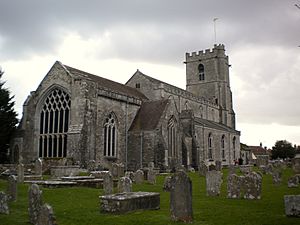Lady St Mary Church, Wareham facts for kids
Quick facts for kids Lady St. Mary Church, Wareham |
|
|---|---|
 |
|
| Country | England |
| Denomination | Church of England |
| History | |
| Founded | circa 800 |
| Dedication | Saint Mary |
| Architecture | |
| Heritage designation | Grade I listed |
| Designated | 7 May 1952 |
| Style | Norman, Gothic |
| Administration | |
| Diocese | Salisbury |
Lady St. Mary Church in Wareham, England, is a very old church with roots in the Anglo-Saxon period. This means it was first built a long, long time ago, around the 8th century. It is famous for a few reasons. One is that it might be the burial place of an old English king named Beorhtric. Another interesting fact is that five special stones with ancient Brittonic writing were found here. These stones date back to the 7th to 9th centuries. The church also has a unique, six-sided lead font that is about 800 years old. A "font" is a basin used for baptisms.
Contents
History of Lady St. Mary Church
The church of Lady St. Mary has a long and fascinating history. Around the year 705, a religious leader named St Aldhelm, who was a Bishop (a high-ranking church official) in Sherborne, likely started a church in Wareham. This church is probably the one we know today as Lady St. Mary.
For a while, there might have been a nunnery (a place where nuns live) connected to the church. However, this building was destroyed in 876 during a raid by the Danes. But the church was not forgotten! Around the year 900, the daughter of Alfred the Great, a famous English king, helped rebuild it.
This church is also important because of its connections to early English royalty. It is believed that King Beorhtric, who ruled Wessex, was buried here in 802. Later, in 978, the body of King Edward the Martyr was brought to Lady St. Mary after he was murdered at Corfe Castle.
About the Church Building
On May 7, 1952, Lady St. Mary Church was given a special status as a Grade I listed building. This means it is considered a very important historical building in England.
The church is mostly built from a type of stone called Purbeck limestone. Its roofs are made of slate and tiles. Inside, the church has a long "chancel" (the area near the altar) and a "nave" (the main part where people sit) with two "aisles" (passageways on the sides).
The south chapel, which is a smaller room for worship, is a bit lower than the rest of the church. It once had a "treasury" above it, which was a secure room for valuable items. The church also has a strong, tall "tower" at its west end. This tower has four main sections and strong supports called "buttressing" on its lower parts.
You can see large windows at both the west and east ends of the church. The one at the east end was added between 1886 and 1890. While the church was first started in the 8th century, different parts were built at different times. The south chapel, for example, dates back to the 12th century, and the tower was likely built in the early 16th century.
Rectors of the Church
A "rector" is the main priest in charge of a church parish. The first rector of Lady St. Mary Church that we know about was Peter de Deserto, who served from 1302 to 1308. Before him, there was a prior named Nicholas Bynet around 1296. In 1678, the role of rector for Lady St. Mary was combined with that of Holy Trinity Church, also in Wareham. John Jones was the first person to be the rector for both churches.
Images for kids


